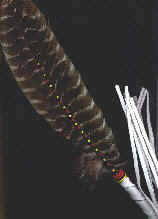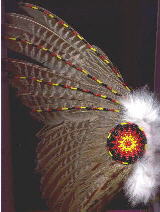|
|
Canku Ota |
|
|
(Many Paths) |
||
|
An Online Newsletter Celebrating Native America |
||
|
September 8, 2001 - Issue 44 |
||
|
|
||
|
Craft Series - Preparing Feathers for Crafts- Part One |
||
|
by Lynne Sageflower Pennington |
|
|
|
| editor's note: Possession of feathers from many birds is strictly controlled by federal and state laws. | |
| How are feather obtained? |
| Most of the time when we buy feathers or are given feathers they are already cleaned.
Below are the ways that were taken before you received the feather. Some feathers are obtained when they fall off the bird which do not need to be cleaned. Others may be obtained from hunting or birds whom have been killed by cars and trucks on the road. These need to be cleaned. The birds that are found on the road must be freshly killed otherwise you will find insects thoughout the body and feathers. This means to leave the carcass there the feathers are damaged. |
| How are feathers preserved? |
| There are several methods to preserve feathers. Here I will talk about one method |
| Preserving body parts: |
| Most hunters start to preserve their birds as soon as they get home by placing the parts
of the bird they want to use in salt. They cover the whole part with salt. This drys the fleshy parts. The type
of salt they use is pickling salt used for preserving and canning or salt that they throw on the driveway during
icy weather. If they are drying a wing they may place it on a board and pin it down in the position they want before covering it with salt. The parts of the bird are left in the salt for about two weeks. If they are not dried out enough then they are left in the salt and checked every week until the flesh is dried out. After they have reached the desired dryness they are then lightly washed with a product like Woolite (soap for delicate washables) and then rinsed. |
| There are a few ways to dry the feathers I will discuss those in a few minutes. |
| Note: If you want to use only the feathers I suggest removing them before placing the part in the salt. If you do not you will be fighting to remove them once the wing or other part is dried. |
| How do I clean the feathers? | |
| There are several ways to clean feathers but this is the way I have found to be the easiest. | |
| 1. | Soak the feathers in Cold water for a few days. Put gloves on and work off the dirt while they are soaking. |
| 2. | After the two days gently pat the feathers with lukewarm water mixed with a mild soap until the remaining dirt and stains are removed. You can also remove any flesh from the bottom quill shaft at this point. You may want to scrap this off with a knife or your fingernails. Just be careful not to cut the quill shaft. |
| 3. | Then rinse them off in lukewarm water. |
| 4. | Do the following procedure outdoor since they may be dusty. To remove the moisture you can lay them in a box and cover them with plaster of paris or a hardwood sawdust. Then using a soft brush, brush the sawdust or plaster of paris from the feather or part. |
| You can clean your fluffy feathers the same way except you do not want to put them in the sawdust. Instead you will let them air dry. | |
| How do I dry the feathers I have washed? | |
| There are a few ways to dry feathers and fluffs. One is by placing them in an Air drying cylinder. I will tell you how to make one. Another way is by holding them in front of a fan or blow dryer. While using these methods you will also be preening the feathers. | |
| How to make an Air drying cylinder. This should be made by an adult since it concerns using power tools. | |
| Materials | |
|
|
| 1. | Drill a hole in the center of the wood circles for a dowel. You want to leave about 1 inch of the dowel sticking out on both ends to tie the rope to. |
| 2. | Tack the screening round one of the wood circles. Leave one end so that is can be removable. I used tacks after I put the removable end on the cylinder to keep it and the screening in place. |
| 3. | Tie the rope on the ends but leave it loose enough because you want to be able to rotate the cylinder. |
| 4. | Place the cylinder in front of a fan and rotate the cylinder |
| 5. | If it is windy outside place it in an area where the wind will go thru the screening. |
| How can I put the luster back into the look of my feathers? |
| Since birds have a natural oil to their feathers sometimes the oil is stripped off. To replace this oil to make them look better you want to rub the feather with a thin coat of unsalted animal grease. |
| Another way it to make some cedar tea and use the tea once it is cooled and wipe down the feathers with the tea. This gives the feathers a light coat of cedar oil. |
| How can I protect my feathers from invasive insects like mites? | |
| There are a few ways to keep mites or invasive insects from you feathers. There are some ways that require the use of air tight containers. | |
| Method One: | Go to a pet store and purchase bird mite spray. Spray down the feathers, then put them in a plastic bag and seal it up tight. Leave them for a few days. |
| Method Two: | When storing feathers or body parts put mothballs in with them. Make sure you use an airtight container because it is the fumes from the mothballs that kill the insects. |
| Method Three: | This one is not for everyone unless you have an extra freezer. Put the feathers or body parts in the freezer for a few days. |
| Most Important of All: |
| If you have received the bird from a hunter or on the side of the highway. Once you have obtained the feathers or parts from the bird you want to use, do not just throw the remains in the trash. Take the remains out into the woods and bury them. Honor the bird and show the bird respect by saying a prayer over the bird to thank it for its feathers and for the life which they came from. |
| Part Two will be on different techniques of Featherwork. |
|
|
||
|
|
||
| Canku Ota is a free Newsletter celebrating Native America, its traditions and accomplishments . We do not provide subscriber or visitor names to anyone. Some articles presented in Canku Ota may contain copyright material. We have received appropriate permissions for republishing any articles. Material appearing here is distributed without profit or monetary gain to those who have expressed an interest. This is in accordance with Title 17 U.S.C. section 107. | ||
|
Canku Ota is a copyright © 2000, 2001 of Vicki Lockard and Paul Barry. |
||
|
|
|
|
|
The "Canku Ota - A Newsletter Celebrating Native America" web site and its design is the |
||
|
Copyright © 1999, 2000, 2001 of Paul C. Barry. |
||
|
All Rights Reserved. |
||


